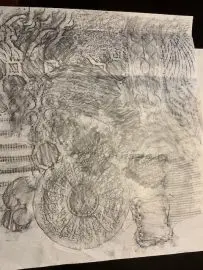Art can provide the boundaries for intense and chaotic feelings, creating safety for them to be expressed in their “bigness”. Art can also be a fun way to bring family members together. It enlivens us, energizes us and is a playful way to explore ourselves. No one needs to possess great talent to do art. Art is a process, not an end. Art doesn’t just feel good, creating art has been proven to facilitate healing. The use of art has been studied in a variety of populations receiving therapy such as veterans, cancer patients, children and the elderly with dementia. Dr. John Diamond, founder of the Arts as Healing Foundation, found that people with dementia and those with other progressive neurological diseases can still create. The creativity continues to be present while other areas of the brain used for language skills and the ability to reason are compromised. Dr. Diamond also found that visual art can reduce stress and create a more relaxed state in our bodies and mind.
Art with guidance has shown to facilitate new understandings, insights, problem solving abilities, and new perspectives that can lead to a more positive outcome and healing. Carl Gustav Jung, considered the father of analytical psychology, designed and used the mandala to tap into the unconscious. Today, Jung’s concept remains in the form of adult coloring books. In nearly every store in the country you can find these coloring books in a variety of designs and interests that intend to guide you towards mindfulness and a state of calm.
Many people have already established their routine art groups, scrap-booking groups and ceramic studios that they attend for their artistic release or the mental/emotional escape from the realities of life? Life is where most of your inspiration comes from. Many people are aware of feeling that creativity pushing against your chest or images bouncing around in your head with no clear direction for birthing them. Indeed, it can feel intimidating to stare at a blank page in a sketch book or the white space of a canvas. Without the direction of a prompt or the creative energy of a class it can feel overwhelming as the pull to create goes head-to-head with the frenetic search for a clear direction to begin. It is important to remember that there is no right or wrong way to do art. You simply must start making marks on the page or gluing items together to discover what your unconscious wants you to know.
I will be presenting art prompts for you to do individually or as a family. Now remember that there is no bad art. In fact, the Japanese call this “Wabi Sabi”, or releasing your unrealistic expectations and embracing the imperfections of being human. If you keep waiting for the perfect moment, the most amazing idea, or all the right materials to create with –you will never begin. Art is in the moment, of the moment and it will pass with the moment just as another moment presents itself. Welcome it. And allow the other moment to leave so that you can have the space for your new guest.

Texture Sketch
- Choose any size of paper you would like, whether it be a large poster size or computer size paper.
- Then place your paper on items inside of the house or outside in your yard that have interesting textures (for example, tree trunks, leaves, textured seating, a lamp base, the top of a lid, or a rough stone).
- With a crayon or pencil lightly color in back-and-forth strokes on the paper and watch the textures appear.
- Create a collage of textures on your paper and fit as many as you can.
- You can choose a variety of colors pencils or crayons..
- Challenge your family to take their own paper and crayon and find as many textures as they can. When you all come back together share them and talk about which textures you found and how you created your design.
Enjoy doing your art and Wabi Sabi to you!!
Dottie Kelly



